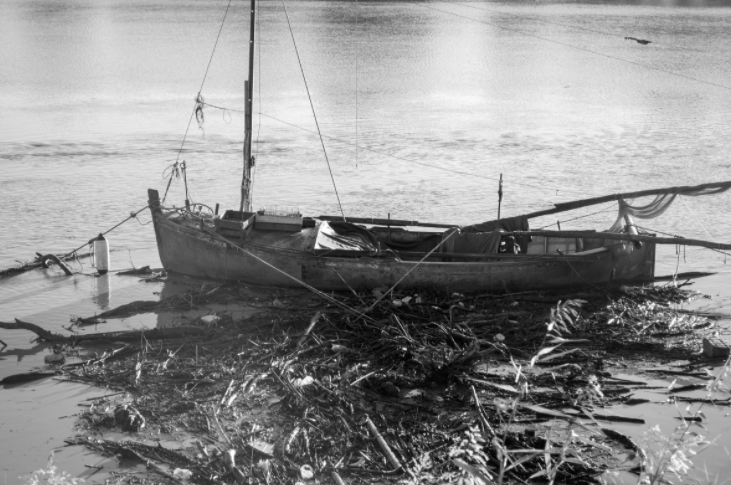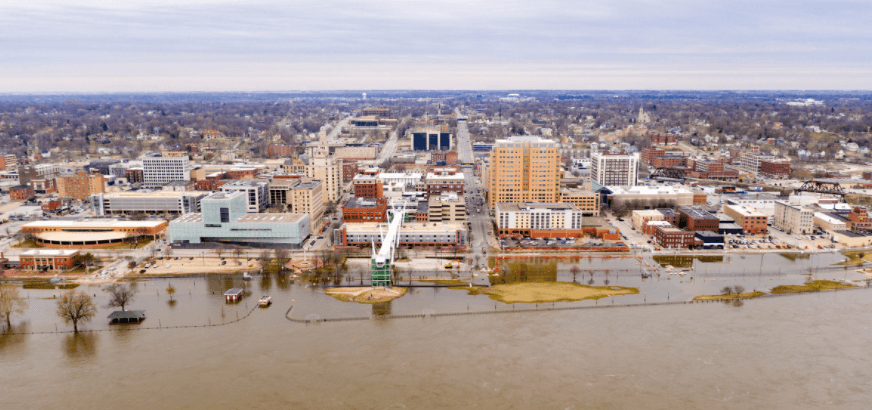
Flowers are all in bloom and dangerous floods may also loom around.
It's a new season as we watch the snow melt and winter wait it out till the end of this year, but this is also the same season with a high risk for flooding due to multiple reasons. Let's talk about the impacts of spring flood for Iowa, how this can impact your flood insurance, and what you should do to prepare for an event that no one wants to happen.

History
The Hawkeye State has been a victim of multiple catastrophic flood events throughout history. This is important for us to know what we can expect in springtime where flood risks are generally starting to increase.
It's notable that most of the major flooding that the state experienced happened around April to July which is generally within the Spring season. To name a couple of these historic floodings, the Great Flood of 1993 devastated the state as a result of months of rainfall accumulating to 48 inches of rain between April and August. More than the storms and consistent precipitation, Iowa also experienced a wet 1992 due to the long and snowy winter season. When Spring came in March 1993, the collected snow and frozen bodies of water significantly impacted the flooding across the state along some streams. This was a pattern that continued until May.

In 2008, the state experienced one of the worst floodings in modern history. This was a time when extensive flooding resulted in a more focused and intense impact on 85 of Iowa's 99 counties. A total of $10 billion in statewide damage was estimated. Just like the 1993 Flood, the main contributor to this flood event was Spring thaw wherein the snowmelt and ice from the winter seep into the ground and runs off the surface into lakes, rivers, and streams. Add to this, the state also had extremely heavy rainfall which results in up to 14 inches of rain.

As you can see, Spring flooding really had a hand in the major floods and river flooding in Iowa, and this might be the same situation at any time come Spring 2021.
Threats
As the Spring season continues to bloom this year, it's important that you're aware of the threats it may bring with it other than hay fever. For one, we've already mentioned that the previous floodings were due to the collection of snow and ice can cause wetness to the soils which cause a lot of trouble for bodies of water which receives this excess water. The Mississippi River and Missouri River are the likely candidates to also contribute to spring thaw. We've seen this happen two years ago and it's not impossible to experience the Midwestern U.S. floods this year.

Since recent data shows that the previous winter season and precipitation brought around 2 inches up to 12 inches of rain in the Midwest region of the country, this is a sign that flooding may occur even in the smallest amount of continuous rainfall. This may also mean that areas closer to a body of water in Iowa State may experience moderate to major flooding, but it's important to understand that even homes far from these bodies of water may experience minor flooding to moderate flooding.
We highly encourage you to be prepared until August has passed. Well, generally we'd like you to make sure that you're always prepared every day of the year since natural disasters don't really give a heads up.
Flood Insurance
It's important that you already have a flood insurance policy in place regardless of the zone designation your property's in according to flood maps. Keep in mind that in most states, Spring is also flood season. You'd best insure your home and make sure that mitigation efforts are made for your community to reduce the risk for flooding significantly. In this season, flood conditions depend not only on the rainfall coming in but whatever was left by the previous season.
You might be wondering what your options are. Well, you have two: the National Flood Insurance Program (NFIP) under the Federal Emergency Management Agency (FEMA) and the federal government itself, and the private flood market.
If you're planning to apply for a flood policy with the NFIP and FEMA, you should start moving now since federal insurance generally takes 30 days before the policy takes effect. When flood levels start rising and your policy isn't active yet, you might have difficulties in restoring what you lost due to flood damage. It's also a good thing to remember that if you're in a high-risk flood area or the special flood hazard area (SFHA), NFIP and FEMA might ask for additional documents which may increase your waiting period to 60 days depending on how quickly you can get these additional documents to them.
The NFIP and FEMA are going to provide a max total of $250,000 for building coverage for residential properties. This amount can go up to $500,000 if you're carrying a policy for a commercial building. Regardless, federal flood insurance also provides coverage for contents which maxes out at $100,000. Unless a presidential declaration is given for your community, you also won't receive additional living expenses coverage. This goes the same for business loss of income or use if you have a commercial building impacted by a flood.

On the other hand, the private flood insurance market can also provide an insurance policy for you. You'd be able to choose from multiple private insurers for your policy. When it comes to a private flood, coverage for property damage can go up to $10,000,000 depending on your property regardless of whether it's residential or commercial property.
This option may also be the fastest one you can get since applications do vary, but remain significantly faster compared to the strict 30-day rule of FEMA and NFIP. The waiting period for policy application, insurance purchase, and its effectivity may only take up to 15 days maximum.

Additionally, private flood generally automatically provides additional living expenses and/or business loss of use with their flood insurance policy coverage. Replacement costs are also going to be a part of policy coverage which means that private flood is most likely to provide you extra coverage in order to replace the contents you lost due to flood damage. Say, your TV was damaged and wrecked by flood water, then private flood is going to provide you the amount of that item if you were to buy it today. This goes for contents in with your insured property, so you can imagine how much coverage that would be.
This season, we'd love to enjoy going out to enjoy the freshness of blooming flowers and whatnots, but this can be ruined by spring flooding. River levels are expected to crest due to the effects of spring coming in and the excess water surfacing to bodies of water, so flood threat and risk for flooding are something you should look out for and protect your property. It's important to keep up with the news and flood forecasts since anything can happen in this season.
If you have questions on flood insurance, flood briefing, risk of the spring season in your community, flood safety, or anything at all about flood, please feel free to reach out to us.
Remember, we have an educational background in flood mitigation, so we'd love to help you prepare for the worst and protect your property's value long term. Click the links below to get in touch and we'll be happy to provide you assistance on everything that's flood education and awareness.




